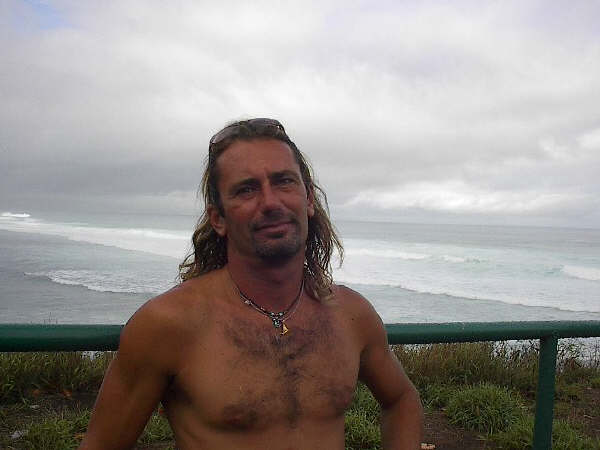The wind and kite surfers went out at Hookipa, here's a couple of photos by Jimmie Hepp from this gallery.
Levi Siver.

Kevin Collins.

Miraculously, I found the time to do some investigation on the wave speed topic I mentioned yesterday and found this article that seemed to be the most reliable. I got to it following some links on this other one, which is a really good read if you have time and want to learn more about waves.
From it, I'm gonna quote this sentence: "It's matter of experience and choice as to what size, period, and swell direction each of us prefers, but if you know what the swell conditions are before you set foot in the water, you'll be a lot better prepared."
That is pretty much what this blog is all about.
Let me also point out this page with the world wide great circles, from where you can get the Hawaii great circles for the north pacific and the Hawaii great circles for the south pacific. The great circles allow you to see from what direction a swell from a fetch in a certain position will come and they take into account the curvature of the Earth, which instead gets distorted in the two dimensional maps that we commonly use.
Below is a table that has the following columns:
- P is the period
- S is the speed at which swells travel in knots (nmph)
- T is the time to cover the 383 nm that separate the NW101 buoy from Maui
- GP's is the approximation of that time if you use the new and improved GP's rule of thumb, which you can easily remember because it goes: 13h at 19s and viceversa.
Everything in between (actually everything between 12 and 21 seconds), you can just interpolate by adding and subtracting 1h to the time and 1s to the period. The maximum approximation you get in the 12 to 21s range is 0.7 hours (42 minutes), which is plenty precise for me, seen the non precise nature of these things. And if you really want to b precise, you can always go to the labels section and check the usual "NW buoy to Maui travel time and shadowing angles" post which just updated.
P S T GP's
10s = 15.6 = 24.5 = 22 n/a 11s = 17.16 = 22.3 = 21 n/a 12s = 18.72 = 20.5 = 20 13s = 20.29 = 18.9 = 19 14s = 21.84 = 17.5 = 18 15s = 23.4 = 16.4 = 17 16s = 24.96 = 15.3 = 16 17s = 26.52 = 14.4 = 15 18s = 28.08 = 13.6 = 14 19s = 29.64 = 12.9 = 13 20s = 31.2 = 12.3 = 12 21s = 32.76 = 11.7 = 11 22s = 34.32 = 11.2 = 10 n/a 23s = 35.88 = 10.7 = 9 n/a 24s = 37.44 = 10.2 = 8 n/a 25s = 39 = 9.8 = 7 n/a
Those travelling time are most correct for a swell that comes from 303 degrees, which is where the NW101 buoy sits compared to us. Any difference in the direction will introduce a difference in the travelling time, which for our purposes I would tend to consider negligible. Just remember that both for more northerly and more westerly swells, the time will be less than what the table says, but the energy hitting the buoy will not be exactly what we receive, so it's not worth to put too much effort into calculating the exact arrival time.
5am significant buoy readings
South shore
Lanai
3.9ft @ 15s from 269° (W)
There were definitely waves in Kihei yesterday, check the webcams to check what's going on today.
North shore
NW101
6.2ft @ 14s from 305° (WNW)
4.9ft @ 10s from 324° (NW)
Waimea
4.5ft @ 14s from 317° (NW)
2.5ft @ 10s from 336° (NNW)
2.2ft @ 12s from 327° (NW)
2.1ft @ 11s from 330° (NW)
Pauwela
4.8ft @ 11s from 321° (NW)
3.7ft @ 15s from 322° (NW)
3.2ft @ 9s from 43° (NE)
1.9ft @ 7s from 65° (ENE)
Below is the graph of the three buoys reported above, so we have a first opportunity to verify the validity of the new and improved GP's rule of thumb. I put an arrow on the peak at the NW101 buoy, which seems to have happened at 4pm Wednesday. The related readings were 15s and by applying the rule of thumb, we get 17h, which would suggest a peak in Maui at 9am Thursday. I put another arrow on the Pauwela's graph to indicate the peak. What do you think, is that 9am? It sure is close enough, the rule worked in this case, but I'll keep testing it for... the rest of my life!
The swell steady declined after that, and that's what we should expect locally throughout the day today. Still plenty energy to play with, but unfortunately a big mix of periods will make the breaking spots and patterns shifty and unpredictable. That's when your wave reading skills come into play. Unless, of course, you can find a spot that filters out some of the shorter period components and only receives the 3.7ft @ 15s from 322° (NW) that are leftover at 5am.
The swell steady declined after that, and that's what we should expect locally throughout the day today. Still plenty energy to play with, but unfortunately a big mix of periods will make the breaking spots and patterns shifty and unpredictable. That's when your wave reading skills come into play. Unless, of course, you can find a spot that filters out some of the shorter period components and only receives the 3.7ft @ 15s from 322° (NW) that are leftover at 5am.
Both Pat Caldwell and Surfline (check picture well below) add a small reinforcement around sunset time, but I don't really see it at the NW101. It wouldn't matter anyway, there's plenty energy still in the water. Stay tuned for the Hookipa beach report around 7am.

Current wind map shows:
1) a newly forming fetch off Japan that is going to provide the next long spell of westerly swells
2) the eastern flank of an "in between storms" high pressure that unfortunately is going to get right on top of us and make for those strong onshores on Saturday in the windguru table below.
3) a small fetch in the Tasman Sea that will generate waves that unfortunately will be completely blocked for us.

Happy to have found the "old Windguru" option (look under "more"), I like it much better.
So, horrible wind on Saturday and Sunday because of that high pressure. I circled in red their wave forecast too, which is based on the NWW3 (NOAA Wave Watch III) model, which at 8am on Sunday calls for 12f 10s from 38 degrees.

The numbers at the same time of that day on the Surfline forecast are quite different: 13f 8s from 70. I thought Surfline based their forecast on the WW3 model too, I might be wrong! I'm gonna monitor both forecasts to find out which one was correct. Tell you what, I really hope that windguru wins the challenge in this case.

Nam3km map at 7am shows great conditions for the north shore.

2pm map looks similar, so no wind related sports today. But do check the MC2km maps when they become available.
 .
.There we go, they did become available in the meantime, let me propose you the 11am one that suggests the start of an onshore flow for the north shore. The NAM3km doesn't have the resolution to show that and the WRF2km is overall a more reliable model, that's why I prefer the MC2km maps. The can occasionally be wrong too, of course. Nothing is certain when you're trying to predict mother nature.











No comments:
Post a Comment